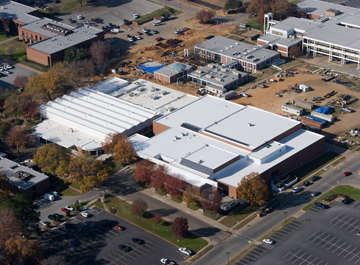The official colors of Tyler Junior College in Tyler, Texas, might be black and athletic gold, but when it comes to campus building roofs, the school prefers to see “white and green.” White, for the color of the Sika Sarnafil EnergySmart Roof® membrane, and “green” for the roof’s energy savings and environmental benefits.
“Tyler Junior College is one of the largest junior colleges in the nation, and our new college president, Dr. L. Michael Metke, wanted to make the campus ‘greener’ and shrink our ecological footprint,” explained Kevin Jones, assistant director of Facilities and Construction at Tyler Junior College. “So when we looked to replace some of the failing roofs at the college, we wanted to find a roofing system that was sustainable and good for the environment.”
Jones did some research on the Internet and found one product that would meet this criterion was the Sika Sarnafil roofing system. Unlike the dark-colored modified bitumen, ballasted EPDM, and BUR roofs previously installed on the college buildings, the EnergySmart Roof reflects 83% of the sun’s rays, thereby keeping the building cooler and reducing air conditioning costs. With an emissivity rating of 90%, the small amount of heat that is not reflected is quickly released back to the atmosphere.
“Our administration also liked the fact that the Sika Sarnafil roofing membranes can be recycled at the end of their useful lives,” Jones said. In fact, Sika Sarnafil recently became the first roofing manufacturer to receive UL recycled content certification.
Although Jones was impressed with the environmental benefits of the Sika Sarnafil membrane, he wanted to be sure that the roofing system would also perform well.
“I read that the Sika Sarnafil membrane was used on the new Dallas Cowboys stadium, so I contacted a Sika Sarnafil representative to learn more,” Jones said. “Not only did he give me a tour of the Cowboys stadium but he also showed me a 30-year-old Sika Sarnafil roof at a Southwest Foods warehouse and manufacturing facility here in Tyler — and that roof looked like it was only 10 years old. That’s when we decided to go with the Sika Sarnafil system.”
The Vaughn Library received the first Sika Sarnafil roof at the junior college in 2010, and the Wagstaff Gym was next. The school has been very pleased with their experience with Sika Sarnafil. Subsequently, Sarnafil® roofs were chosen for the campus Information Technology Building, the Genecov Science Building, and for the college’s Hudnall Planetarium.
“We wanted a roofing system that wouldn’t need any attention for a long time, and to date we have never had a single call or issue with any of the Sika Sarnafil roofs,” Jones said. “In fact, our goal is to install Sika Sarnafil roofing systems on all of our flat roofs.”
He added, “Sometimes following a green initiative is not economically feasible, but that’s not the case with the Sika Sarnafil roofs. They have a durable, long-lasting, energy efficient product backed up by a worldwide company.” BD+C
Related Stories
| Oct 4, 2011
GREENBUILD 2011: Wall protection line now eligible to contribute to LEED Pilot Credit 43
The Cradle-to-Cradle Certified Wall Protection Line offers an additional option for customers to achieve LEED project certification.
| Oct 3, 2011
Magellan Development Group opens Village Market in Chicago’s Lakeshore East neighborhood
Magellan Development Group and Hanwha Engineering & Construction are joint-venture development partners on the project. The Village Market was designed for Silver LEED certification by Loewenberg Architects and built by McHugh Construction.
| Oct 3, 2011
Balance bunker and Phase III projects breaks ground at Mitsubishi Plant in Georgia
The facility, a modification of similar facilities used by Mitsubishi Heavy Industries, Inc. (MHI) in Japan, was designed by a joint design team of engineers and architects from The Austin Company of Cleveland, Ohio, MPSA and MHI.
| Oct 3, 2011
Cauceglia to lead Allsteel’s global accounts
Cauceglia is responsible for developing new global business strategies and expanding existing business within the Fortune 500 sector.
| Sep 30, 2011
BBS Architects & Engineers completes welcoming center at St. Charles Resurrection Cemetery
The new structure serves as the cemetery's focal architectural point and center of operations.
| Sep 30, 2011
Kilbourn joins Perkins Eastman
Kilbourn joins with more than 28 years of design and planning experience for communities, buildings, and interiors in hospitality, retail/mixed-use, corporate office, and healthcare.
| Sep 30, 2011
Design your own floor program
Program allows users to choose from a variety of flooring and line accent colors to create unique floor designs to complement any athletic facility.
| Sep 30, 2011
AAMA offers electronic technical documents with launch of virtual library
This new program offers a system for members to purchase annual licenses in order to offer electronic versions of AAMA publications in an effort to make AAMA’s technical information resources more readily available to their employees.
| Sep 29, 2011
Submit your Great Solutions
Profiles of Great Solutions will appear in December 2011 issue of Building Design+Construction.
| Sep 29, 2011
Busch Engineering, Science and Technology Residence Hall opens to Rutgers students
With a total development cost of $57 million, B.E.S.T. is the first on-campus residence hall constructed by Rutgers since 1994.
















